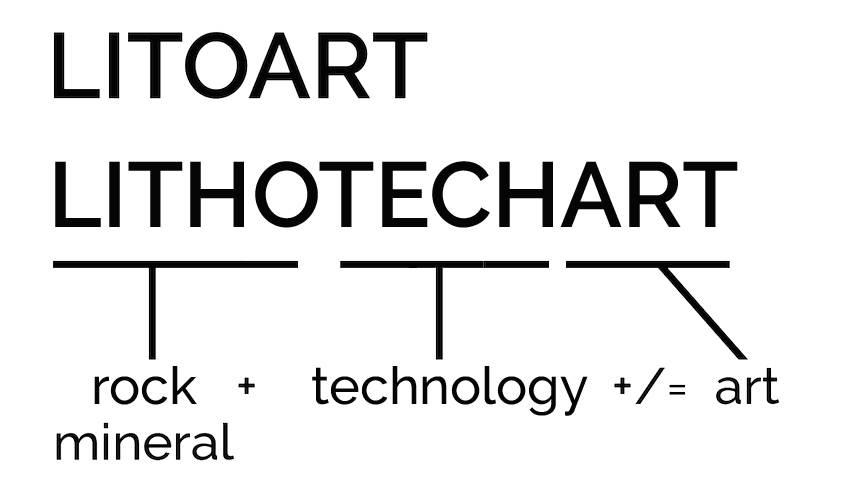CERTEZAS
LITOLÓGICAS
SOBRE EL LITO-TEC-ARTE
ABOUT LITHO-TECH-ART
Paloma Marquez - Certezas Litológocas - 2020
Tesis Maestría en Tecnología y Estética de las Artes Electrónicas
Universidad Nacional Tres de Febrero
← Volver
Durante esta investigación, surgió la necesidad de sectorizar y nombrar un campo artístico el cual reúna las obras que involucran rocas entre sus componentes. LitoArt es el nombre que propongo para este género, compuesto por Lito del griego λίθος líthos 'piedra' y Art o arte por el área de investigación. El concepto que se desprende es LitoTecArte. El agregado del -tec, reúne específicamente a las obras que implican el uso de tecnología con la roca como parte constitutiva de la misma y de manera colaborativa entre los elementos que componen la obra: artista-mineral-tecnología.
Conceptualmente desde un punto de vista ecológico, estas obras revalorizan a la roca en su estadio natural, resignificando el aspecto primitivo de los minerales en circuitos electrónicos-artísticos. Se puede plantear una relación bilateral entre humano y la roca, teniendo en cuenta a esta última como agente actuante. Estos aspectos abren un gran campo de posibilidades por investigar, tanto en el espectro teórico, como poético.
En la producción de obras de LitoTecArte; artistas, minerales y dispositivos tecnológicos conforman un conjunto de interrelaciones multi-agente, deviniendo-con, es decir, volviéndose reciprocamente capaces de sumar sus devenires-con (Haraway, 2019, p. 53), y permitiendo a su vez el florecimiento de las habilidades de cada participante. “(...) Creating art with stone is not the domestication of an element, but a human-lithic collaboration that recognizes the art stone already holds.” [(...) Crear arte con roca no es la domesticación de un elemento, sino una colaboración litico-humana que reconoce el arte que la roca contiene previamente] (Cohen, 2015, 61)
Las obras son una parte del cúmulo de elementos y relaciones que se interconectan, superponen y alimentan entre sí. Todos los elementos acarrean una historia, poética, capacidad, antecesor y sucesor, entre otros vínculos, de los cuales no pueden ser aislados. A su vez generan lazos dinámicos y multilaterales, que pueden extenderse, solidificarse o cortarse.
El siguiente gráfico presenta una posibilidad de red de colaboraciones y vinculaciones que conforman la obra de LitoTecArte, la cual varia, evoluciona y es permeable a incorporar elementos y relaciones necesarias. Esta configuración es el resultado de procesos y conexiones hábidas de cambios constantes, en el registro audiovisual presento la evolución en la red de vinculaciones de las cuales resultan las imágenes presentadas aquí.
During this research, the need to name an artistic field which brings together art works that involve rocks among its components. LitoArt is the name that I propose for this genre, consisting of Litho from the Greek λίθος lithos 'stone' and Art by the research area. The concept that emerges is LithoTechArt. The addition of -tech, specifically brings together works that involve the use of technology with rock as a constituent part of it and in a collaborative way among the elements that make up the work: artist-mineral-technology.
Conceptually from an ecological point of view, these works revalue the rock in its natural stage, resignifying the primitive aspect of minerals in electronic-artistic circuits. A bilateral relationship between human and rock can be considered, taking into account the mineral as an active agent. These aspects open a wide field of possibilities to investigate, both in the theoretical and poetic spectrum.
In the production of LitoTecArte works; artists, minerals and technological devices make up a set of multi-agent interrelationships, becoming-with, that is, becoming reciprocally controlled to add their accruals-with (Haraway, 2019, 53), and in turn the blossoming of the skills of each participant "(...) Creating art with stone is not the domestication of an element, but a human-lithic collaboration that recognizes the art stone that it already has". (Cohen, 2015, 61)
The works are a part of the accumulation of elements and relationships that interconnect, overlap and feed each other. All the elements have a history, poetics, capacity, predecessors and successors, among other links, from which they cannot be isolated. They also generate dynamic and multilateral ties, which can be extended, solidified or cut.
The following graph presents a possibility of a network of collaborations and links that make up the work of LitoTecArte, which varies, evolves and is permeable to incorporate necessary elements and relationships. This configuration is the result of the usual processes and connections of constant changes, in the audiovisual record I present the evolution in the network of connections.


